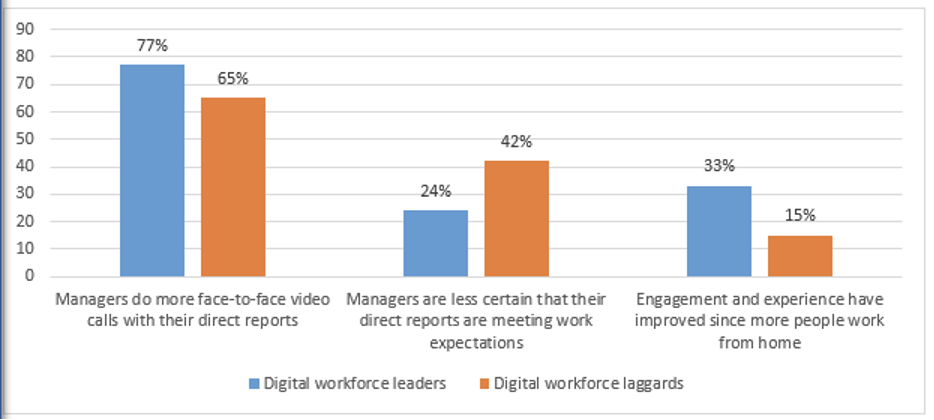The “Digital Workforce in 2021” survey ran in February and March, 2021. We gathered 284 usable complete and partial responses, primarily from HR professionals in virtually every industry vertical.
The survey was conducted by HR.com’s HR Research Institute in partnership with Accurate Background, a leading provider of compliant background checks, drug and health screening, and Form I-9 verifications.
Respondents to the survey were required to have operations in the U.S. but could be headquartered or have additional operations anywhere in the world.
The participants represent a broad cross-section of employers by number of employees, ranging from small businesses with fewer than 50 employees to enterprises with 20,000+ employees.
In this series of blog posts, we take a deep dive into our major findings based on this research and the implications for organizations now working in an increasingly digital environment.
What the Best Do, That the Rest Don’t: Best Practices of Digital Workforce Leaders
Major Finding Seven: Organizations that more often give managers the technology, tools, education, and training to support a remote workforce well are more likely than others to:
- Provide a culture that supports remote work environments.
- Give employees access to all the tools they need to work from anywhere.
- Use video technology for hiring and interviewing.
- Hire more non-local candidates and people who will only work remotely in the future.
- Incorporate background checks more often.
- Rely less on manual onboarding processes.
- Use a wider range of communication methods, including more face-to-face video calls.
Our research uncovered a number of best practices that set digital workforce leaders and digital workforce laggards apart.
In our final post in this series, we take a look at some of these best practices.
Digital workforce leaders and laggards.
As we analyzed the responses to our research, we segmented the data into two groups:
- Digital workforce leaders: those who “strongly agreed” or “agreed” that their organization’s managers were getting all of the tools, technology, education, and training to manage the remote workforce well.
- Digital workforce laggards: those who “strongly disagreed” or “disagreed” that their organization’s managers were getting all of the tools, technology, and training to manage the remote workforce well.
While recognizing that correlation is not the same as causation, we still found some intriguing relationships in the data that could point to opportunities for organizations to best leverage the value of their remote workers while increasing their engagement and productivity.
Implementing best practices for better remote workforce management.
Culture Matters
Digital workforce laggards were more likely to recognize a cultural divide between employees working from home (WFH) and those not able to work remotely (45%) than digital workforce leaders (29%). This may indicate that digital workforce leaders are more likely to focus on achieving goals, regardless of where employees are located, than valuing facetime in the office.
Focusing on cultural issues is important to avoid lost productivity or lack of engagement. As a report from Dale Carnegie points out, “it’s important that the organization’s intended culture doesn’t get lost, since it’s a critical driver for long-term success.”
But Remote Employees Need the Right Tools
While culture is important when managing a remote workforce, it’s also critical that remote employees have the right tools available to them to work effectively in a remote environment. In addition to access to a computer, they may mean access to a wide range of other tools from file-sharing tools (like Google or Dropbox), to messaging services (like Skype), and virtual conferencing tools (like Zoom and Microsoft Teams).
Each organization will differ in terms of the tools its remote workers will need. And, in fact, there will also be variations between departments and the various roles within the organization. It’s important for managers to stay connected with employees and to fully understand the tools required for them to operate at maximum productivity.
Engagement and Experience Can Improve in a WFH Environment
Engagement doesn’t have to suffer in a WFH environment. In fact, organizations and their managers and employees have been greatly aided by technology to allow them to continue to have important connections. Digital workforce leaders (77%) are more likely than laggards (65%) to indicate that their managers use face-to-face video to communicate with employees. Leaders were also far more likely (33%) to say that employees were more engaged in moving to a remote environment than laggards (15%).


Reaching a Broader Talent Pool
Remote work has led to some new insights into how to attract and retain talent. One has been the recognition that employees can be drawn from broader geography when work is done remotely. And, in fact, far more digital workforce leaders (35%) have started reaching out to a broader base of potential employees than laggards (7%). They are also more likely (22%) to indicate that they will likely hire more people who will only be remote in the future than laggards (9%).
Less Reliance on Manual Onboarding
For those hiring during the pandemic, it quickly became apparent that manual onboarding processes were ineffective and could not only stall the process but might also result in lost opportunities to attract top talent. Digital workforce laggards were more likely to rely on highly manual onboarding processes (27%)—like asking employees to complete and return paperwork physically—than workforce leaders (12%).


Conducting Background Checks
One final area of divergence between digital workforce leaders and laggards is the use of background checks when hiring new employees. Digital workforce leaders use pre-employment screens more often than laggards—in fact, laggards are three times more likely (17% vs. 6%) to say they do no background screening at all.
In a remote work environment, as employees are found, interviewed, screened, and onboarded remotely, background checks will likely become more critical than ever before.
Background checks can be complex—even more so when hiring across a wide range of geographies with different laws and rules in place. Accurate can help. Accurate provides customized background screening, drug testing, and I-9 solutions through innovative, web-based technology. Accurate creates background screening programs for each client based on their specific hiring processes; solutions seamlessly interface with the HR technology or applicant tracking systems they have in place.



